Hearthstone is a well-known Digital Collectible Card game. The game has a lot of players, it’s fun, and overall, anyone can play the game if they start whenever. Thus, to help the new players, we’re here to talk about the current meta via our Hearthstone arena tier list for decks. To know what decks you should use in a competitive setting, continue reading our Hearthstone Arena tier list article.
What Is Hearthstone?

Hearthstone is an online, free-to-play, digital trading card game based on the Warcraft universe. It was created, and released, of course, by Blizzard Entertainment and was supposed to have the subtitle “Heroes of Warcraft”. They scrapped that and just left it as Hearthstone after a few years. The game was created to build upon, and maybe even tweak, some of the series’ lore for the main entries. These can range from adding in certain character quirks, new elements on faction dynamics, and a whole slew of other things.
The game first came out back in March of 2014 for PC and macOS. Then, the game was released on mobile platforms like Android and iOS for the mobile players, for good reason. After all, the game is incredibly fun to play, and has a lot of depth to it, most of the time. Looking at the beat stick decks like straight-up summoning Deathwing to annihilate entire rows here.
Still, the game does give a lot of leeway in terms of playstyle, but only on casual play. If you want to go for the Ranked Ladder climb, you need to get the Meta Decks. But before we go into our Hearthstone Arena tier list, let us take a look at the current meta of the game.
What Is The Current Meta in Hearthstone Arena Mode?
As of right now, Hearthstone released a new Card Pack by the name of “Forged in the Barrens”. And as per usual, all of the new cards released are subject to increased scrutiny. These cards, after all, can change the face of the meta for a lot of decks.
However, as of right now, the Forged in the Barrens card pack hasn’t made a lot of waves in terms of game-changing Metas. This is because one of the previous card packs, Scholomance Academy, still has a lot of game-changing cards. Not to say that Forged in the Barrens is a bad card pack addition. It, and its mini-set, the Wailing Caverns, added a lot of new cards in the game. Overall though, the new card pack only changed a few things about several decks.
As of right now, the Forged in the Barrens card pack and its mini-set has gone down in popularity a bit. One reason for this is because the new card pack smell has faded. Meanwhile, another is because there’s not much change in the current meta with their addition. Well, except for a few deck builds that we’ll talk about later.
As for other card packs, the “Madness of the Darkmoon Faire” and “Ashes of Outland” still enjoy a lot of popularity. This is also due to the number of cards in the packs that help in several of the decks we’re going to talk about today.
Note: New expansions will affect future Hearthstone Arena tier lists and the meta itself.
Hearthstone Arena Tier List
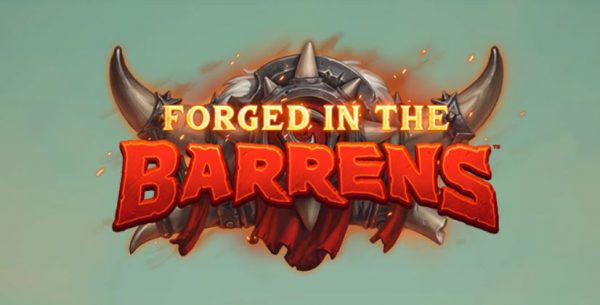
As of right now, Hearthstone is in a state of flux, especially when new card packs are being introduced. The Hearthstone meta and decks in the Arena tier list are constantly shifting, and some top tiers, like Paladins, can drop like a rock with a few additions to the game as well as nerfs. For now, though, let’s talk about decks that you need to have on the road to climbing the Ranked ladder. Here’s our Hearthstone Arena tier list.
S Class
We’ll first start with the top of our Hearthstone Arena tier list, the S Class. These decks, if you’re lucky to have the cards that make them, are just about the best decks that you can get in the game right now. If you have these, you might find more frequent wins on the Ranked ladder no matter where you are in the ranks. To start, we’ll first talk about Rush Warrior, Aggro and Elemental Shaman, and surprisingly, Control Priest. Let’s get started.
Rush Warrior
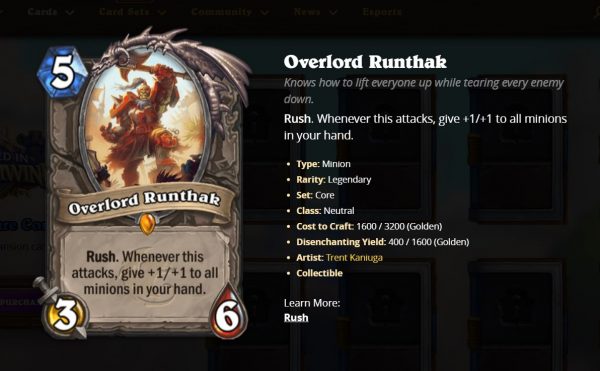
Rush Warrior is a deck archetype that was created through the release of Forged in the Barrens. Some would even say that the deck’s conception is thanks to the new card pack. This deck is incredibly aggressive, emphasizing ensuring a win early on.
The deck makes liberal use of rush minions, as well as cards that boost rush minions, to get victory ASAP. The more minions and buffs that the deck can field, the bigger the snowball effect of wave after wave of minions rushing to kill the enemy Hero. The deck does this by having older cards like Parade Leader and Crabrider deal with the aggression. Meanwhile, newer cards like Blademaster Saburo adds to the deck’s utility and fighting strength.
Combine that with the ability to straight-up finish a game of Hearthstone by destroying entire board layouts with good trades? And well, you can see why this deck is one of the best decks currently in the game.
And with the above reason combined with the addition of new cards in the Wailing Caverns mini-set? Well, that means that Rush Warrior is currently at the tippy top of the Tempo Storm Meta.
Why? Well, this is due to the new combos that became available with the addition of the new cards, and the deck’s raw power.
Rush Warrior Deck List
- 2pcs. Athletic Studies
- Stage Dive x2
- Warmaul Challenger x2
- Conditioning (Rank 1) x2
- Imprisoned Gan’arg x2
- Crabrider
- E.T.C., God of Metal
- Archdruid Naralex
- Bumper Car x2
- Rokara
- Sword Eater x2
- Blademaster Samuro
- Overlord Runthak
- Playmaker x2
- Tent Trasher
- Ringmaster Whatley
- Troublemaker x2
- Kresh, Lord of Turtling
- Parade Leader x2
- Alexstrasza the Life-Binder
Control Priest

Next up is Control Priest, a deck archetype that emphasizes healing minions while removing the enemy’s own. The main trick of the Control Priest deck is ensuring that they can control the game by using as many efficient spells as possible. Meanwhile, they fatigue the other player through the survivability of their cards as well as sheer value generation.
Control Priests in general try to control the game in the early and midgame. This is done through careful use of removal spells to take out threats. For example, the player managed to damage Alexstrasza. On your next turn, you gain Execute; you can then use it to destroy Alexstrasza without needing to attack her again. In Control Priest, that role is taken by Holy Smite, which can be added into the deck when necessary. Still, the deck makes sure that the enemy is kept on the backfoot with a ton of buffed minions. Meanwhile, they also have spells that deny them strong minions of their own.
The deck didn’t have that much in terms of game-breaking additions on the new expansion and Mini-set. They did, however, gain Xyrella, who can shred entire enemy lineups every time the player restores health.
Overall, a good Control Priest player can and will destroy unprepared players.
Control Priest Deck List
- Raise Dead x2
- Renew x2
- Draconic Studies x2
- Condemn (Rank 1)
- Sethekk Veilweaver x2
- Wandmaker x2
- Archdruid Naralex
- Apotheosis x2
- Palm Reading x2
- Mindrender Illucia
- Venomous Scorpid x2
- Hysteria x2
- Blademaster Samuro
- Southsea Scoundrel x2
- Xyrella
- Lightshower Elemental x2
- Mutanus the Devourer
- N’Zoth, God of the Deep
- Soul Mirror
A+ Class
This is the section of our Hearthstone Arena tier list where we put decks that are above A-Class but don’t have the power to become S Class decks. We’ll start with the Aggro and Elemental Shaman decks, and lastly, the Deathrattle Demon Hunter deck.
Aggro Shaman

Aggro Shaman in its current form wants to drown the enemy in the midgame. They do this with cards like Torrent and Lightning Bolt, combined with cards like Rockbiter Weapon to boost minions. The deck archetype may be old, but it still has some fuel to burn those young whippersnappers. Because of the Burst-heavy nature of the deck though, there are some decks in the meta that can outlast it. But if they play their cards right, they’ll be able to crush the opposition.
The rise of Aggro Shaman in the meta’s ranks came out of nowhere. However, the rise is also helped by a few of the new cards in the new mini-set. Specifically, Cagemach Custodian, Novice Zapper, Inara Stormcrash, and Doomhammer.
Thanks to the new units, Aggro Shaman was able to hold strong and become one of the best decks in Ranked. You could even say that Wailing Caverns was the catalyst on its rise in the game. After all, the deck’s main problem was consistency due to being unable to put pressure on the early game. They also needed to get Doomhammer on their hand to screw over the enemy player. Thanks to Wailing Caverns, these problems became moot.
Aggro Shaman Deck List
- Wandmaker x2
- Lightning Bloom x2
- Perpetual Flame x2
- Lightning Bolt x2
- Wailing Vapor x2
- Cagemach Custodian x2
- Rockbiter Weapon x2
- Archdruid Naralex
- Primal Dungeoneer x2
- Diligent Notetaker x2
- Instructor Fireheart
- Speaker Gidra
- Serpentshrine Portal x2
- Stormstrike x2
- Dunk Tank
- Torrent x2
- Inara Stormcrash
- Doomhammer x2
Elemental Shaman
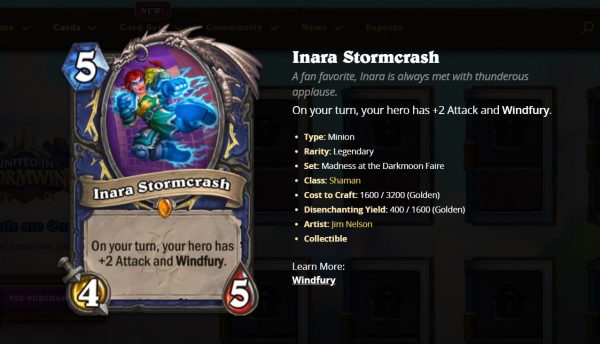
The deck is aggressive, but more on the midrange in terms of aggro and control. After all, the more elemental synergies they get, the better their board control. However, if they feel that they’re not dealing enough damage, adding Doomhammer helps.
As for playstyle, Elemental Shaman strikes fast and hard. Wailing Caverns, and in general Forged in the Barrens, added in several powerful additions to the Elemental Shaman lineup. This allowed the deck to rise through the ranks to become one of the A-Class decks in the meta. Thanks to the new cards, the early game is no longer a problem, and their draw power is monstrous. When combined with cards that can swing the tempo of the game at a whim if used correctly? Well, you can see why Elemental Shaman rose to prominence.
What’s surprising is the fact that Elemental Shaman wasn’t in the game’s ranked meta for a long while now. The addition of Forged in the Barrens and Wailing Caverns helped in its rise to the game’s highest tiers. In general, the Shaman class was one of the classes that benefited the most from the new expansion.
In terms of new cards, Inara Stormcrash, Primal Dungeoneer, and Wailing Vapor take the stage. The latter two for Draw power, and Inara for the buffs that she can give.
Elemental Shaman Deck List
- Lightning Bloom x2
- Diligent Notetaker x2
- Wailing Vapor x2
- Kindling Elemental x2
- Cagematch Custodian x2
- Rockbiter Weapon x2
- Instructor Fireheart
- Gyreworm x2
- Primal Dungeoneer x2
- Stormstrike x2
- Arid Stormer x2
- Kazakus, Golem Shaper
- Doomhammer x2
- Inara Stormcrash
- The Lurker Below
- Lilypad Lurker
Deathrattle Demon Hunter
Another new class variant is Deathrattle Demon Hunter, a variant that came out due to the new expansion. Deathrattle Demon Hunter plays similarly to a midrange deck and gets stronger the more minions the player summons through Deathrattle effects.
However, the deck needs an engine from which to start the pain train, and that engine is the Razorfen Beastmaster. It’s thanks to this minion that other Deathrattle minions can be summoned quickly into the board, especially strong Deathrattle minions like Renowned Performer who can also summon their minions. The more minions the Deathrattle deck summons, the better they can control the fight through summons and Deathrattle effects. The more minions they have on the board, the more fodder they have to shank an enemy with.
If the player is lucky though, they might be able to get Death Speaker Blackthorn. Blackthorn is a 7 cost Minion that summons cost 5 and below minions straight from the deck. With luck, these minions can then summon their minions, thanks to Deathrattle effects when they die. In short, though, the more minions that die in your board, the more minions you’ll have in battle. And even if those minions die, some of them can summon their minions as well. This strains the enemy’s cards as they need to expend them to deal with your minion fodder.
Deathrattle Demon Hunter Deck List
- Illidari Studies x2
- Tuskpiercer x2
- Sneaky Delinquent x2
- Razorboar x2
- Ace Hunter Kreen
- Raging Felscreamer x2
- Death’s Head Cultist x2
- Felrattler x2
- Devouring Ectoplasm x2
- Felsteel Executioner x2
- Razorfen Beastmaster x2
- Kurtus Ashfallen
- Renowned Performer x2
- Taelan Fordring
- Death Speaker Blackthorn
- Glide x2
- Illidari Inquisitor x2
A Class
Now that we’ve finished the A+ Class, let’s about the A-Class decks in our Hearthstone Arena tier list. These decks are the ones that have a solid streak in terms of wins in ranked but aren’t powerful enough to break through to A+ or S. We’ll start with OTK Demon Hunter, then Aggro Hunter, followed by Miracle Rogue, and lastly, Token Druid.
OTK Demon Hunter
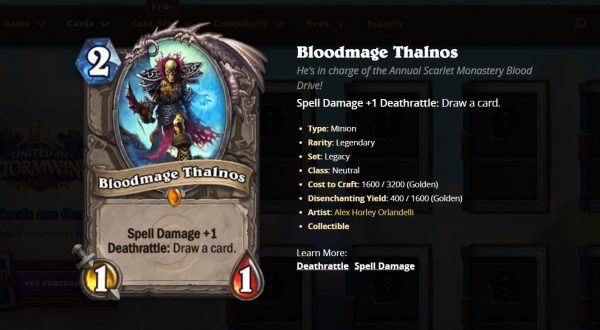
This deck is built to make sure that the opponent dies in one turn when the cards align. This deck requires a lot of prep time and a good head on the player’s shoulders to win. But with efficiency, a deck built for the strategy, and maybe some luck? Well, players can just go and reduce a full HP enemy to zero incredibly quickly.
To do this, players need to have Felscream Blast, Mo’arg Artificer, two Talented Arcanists, and Il’gynoth. Talented Arcanists increase spell damage by 2 for 1 turn, Mo’arg Artificer doubles spell damage on minions and Il’gynoth? Il’gynoth, plus Felscream Blast is the real game-changer. Il’gynoth makes it so that any lifesteal effects will instead damage the enemy Hero. This, combined with Felscream Blast damages a minion and those beside it with 1 damage and heals the player’s Hero. All in all, Felscream Blast, with the 2 Talented Arcanists and Mo’arg Artificer will deal a combined 30 damage, enough to kill an enemy.
To get this combo though, several things need to happen, thus, enormous amounts of drawing power are needed. Thanks to Madness of the Darkmoon Faire though, the draw power problem of the deck is solved. Players do need to have at least 2 Skulls of Gul’dan to use the deck to its fullest potential though. This is because it allows players to draw 3 cards while also reducing their cost if Outcast is activated.
OTK Demon Hunter Deck List
- Double Jump x2
- Ethereal Augmerchant
- Felosophy x2
- Felscream Blast x2
- Illidari Studies x2
- Throw Glaive
- Acidic Swamp Ooze
- Bloodmage Thalnos
- Chaos Strike x2
- Immolation Aura x2
- Mo’Arg Artificer x2
- Spectral Sight x2
- Talented Arcanist x2
- Aldrachi Warblades x2
- Eye Beam x2
- Il’gynoth
- Raging Felscreamer
- Skull of Gul’dan x2
Aggro Hunter
Next up on the list is Aggro Hunter, a deck that wishes to finish games as fast as possible. To do this, they use a lot of low-cost burn spells and minions that have a lot of uses. The deck is incredibly good with using spells that have low cost, and combined with Kolkar Pack Runner? Yeah, that board will be filled with Hyenas that attack every minion on the enemy’s board.
In addition to this, the addition of Warsong Wrangler and Trampling Rhino turned this deck into a viable threat. This is mostly due to the ability that both cards have been able to turn whole games into stomping grounds. Combine that with the fodder that is Wolpertinger straight up summoning an army out of nowhere? And yeah, Aggro Hunter can and will turn your hero’s health into sliced bits in seconds if you let it.
However, this deck also runs the risk of getting board wiped by Control Priest decks. Also, Aggro Hunter players better hope they don’t meet an Anduin, so that hero can turn this deck into free Ranked points.
Aggro Hunter Deck List
- Adorable Infestation x2
- Intrepid Initiate x2
- Tracking x2
- Demon Companion x2
- Truealm Crescent x2
- Wolpertinger x2
- Imprisoned Felmaw x2
- Kolkar Pack Runner x2
- Quick Shot x2
- Mankrik
- Ace Hunter Kreen
- Wound Prey x2
- Piercing Shot x2
- Rinling’s Rigle
- Warsong Wrangler x2
- Barak Kodobane
- Trampling Rhino x2
Miracle Rogue

Next up is Miracle Rogue, an old favorite of many players back in the days, but has now made a slight comeback. Usually, Miracle Rogue decks make use of the Gadgetzan Auctioneer as the deck’s engine. Nowadays, this card’s been replaced with others on the Forged in the Barrens expansion, specifically Field Contact. The main difference between the two is the way their effects work. Gadgetzan Auctioneer allows players to draw a card every time they cast a spell. Meanwhile, Field Contact draws a card every time players use a Battlecry or Combo card.
In short, Field Contact is for players that want to play fast and loose. Players need to have a strong tempo for Field Contact to be viable; losing that tempo would mean defeat. Sadly, Miracle Rogue didn’t get any new cards from the new expansion. They do, however, still hold to their A-Class rank because of how good their looping is. That, and the fact that the deck is incredibly balanced no matter what it’s facing.
Miracle Rogue Deck List
- Shadowstep x2
- Brain Freeze x2
- Guardian Augmerchant x2
- Prize Plunderer x2
- Secret Passage x2
- Wand Thief x2
- Cult Neophyte x2
- Efficient Octo-bot x2
- Foxy Fraud x2
- Swindle x2
- Tenwu of the Red Smoke
- Vanessa VanCleef
- Wicked Stab (Rank 1)
- Field Contact x1
- Mankrik
- Kazakus, Golem Shaper
- Jandice Barov
- Alexstrasza the Life-Binder
Token Druid
The last deck we need to talk about in the A-Class is Token Druid. Token Druid is a deck that uses various spawns, minions, and buffing cards that turns his side of the board into a nightmare to deal with. There are many variations of Token Druid depending on the style of the player in question. There are a few that prefer to flood their board with as many minions as possible. Meanwhile, another playstyle would be to slowly, but surely, ramp up the aggression, using buffs to boost the power of their minions until they’re too strong.
The deck’s general playstyle remained unchanged for most of the current meta, even with the release of new expansions. Arbor Up is still being used to buff minions while summoning new minions for the enemy to chew on. This card’s the main card of the entire deck and is the definite go-to for Token Druid players.
Other than Arbor Up though, Solar Eclipse can be used to great effect to beef up the field. The fact that you can double-cast a spell at only 2 cost can be clutch in some situations. In addition, the Token Druid deck is pretty malleable, with some cards in the deck being replaced with other cards depending on the enemy.
Token Druid Deck List
- Adorable Infestation x2
- Innervate x2
- Solar Eclipse x2
- Lightning Bloom x2
- Nature Studies x2
- Guess the Weight x2
- Throngrowth Sentries x2
- Fungal Fortunes x2
- Pride’s Fury x2
- Lunar Eclipse x2
- Soul of the Forest x2
- Power of the Wild x2
- Arbor Up x2
- Gibberling x2
- Glowfly Swarm x2
B Class
Now that we’ve finished with the A-Class decks, let’s talk about the B-Class decks. These decks in our hearthstone Arena tier list have a reasonable amount of power. However, they either fell off the ranks due to new cards, or their effectiveness got cut because of newer strategies. That, or they came from the C-Class and got better, but not by much.
To start with this, we’ll talk about Secret Rogue. After that, Libram Paladin, Spell Mage, and lastly, Clown Druid.
Secret Rogue
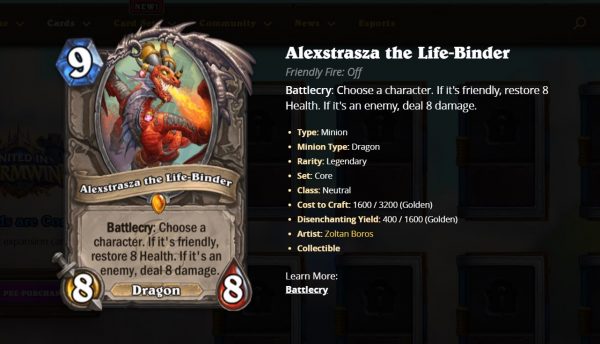
Secret Rogue is a deck that relies on Tempo. It’s the deck that took some inspiration from the Miracle Rogue deck on the A-Class. However, the deck will instead use the tempo that they can go for to finish the game quickly. Meanwhile, the older version of Miracle Rogue uses Gadgetzan Auctioneer to increase card draw and usage.
The deck currently peaked back on the Madness of the Darkmoon Faire expansion with the addition of Swindle. The addition of an extra spell and possibly a minion makes Swindle a great addition to Secret Rogue. Combine that with Dirty Tricks and Shadowjeweler Hanar and you have several combo possibilities to outdraw and flood your opponent.
Unfortunately, though, Secret Rogue has stalled a bit due to not getting any support on the new expansion. It’s a sad thing to see as Secret Rogue is a fun deck to play with. There’s a lot of cool combos that players use to achieve a victory that’s only possible through Secret Rogue. For now, it’s going to be in the B Class, and let’s just hope that Blizzard will give the deck some love soon.
Secret Rogue Deck List
- Shadowstep x2
- Blackjack Stunner x2
- Prize Plunderer x2
- Wand Thief x2
- Ambush x2
- Bamboozle x2
- Dirty Tricks x2
- Efficient Octo-Bot x2
- Shadowjeweler Hanar
- Swindle x2
- Tenwu of the Red Smoke
- Wicked Stab (Rank 1) x2
- Mankrik
- Sparkjoy Cheat x2
- Kazakus, Golem Shaper
- Jandice Barov
- Alexstrasza the Life-Binder
Libram Paladin
Next up is Libram Paladin, a deck archetype that uses a few of the Libram cards available in Hearthstone. Most of the time, Libram Paladin players use the Libram cards to get an advantage in the game and to get resources. After that, they’ll then proceed to attempt to obtain board control and never let go. Sometimes though, they might lack the damage to kill off the enemy, but that’s where Lady Liadrin comes in. She, alongside a low-cost Libram of Wisdom, is usually enough to kill off any Hero once they’re low enough.
In addition to this, First Day of School as well as Pen Flinger helped in pushing the archetype to the meta. Forged in the Barrens added in several new stuff as well, like Northwatch Commander and Sword of the Fallen. The deck also gained several deck thinning effects, which they can use to lessen the opponent’s options.
However, even after all that, Libram Paladin still went down the rankings alongside other Paladin decks. Now, the deck has floundered into B Class because of the Wailing Caverns mini-set. In addition to this, Libram Paladin now has a lot of unfavorable matchups due to the addition of several powerful cards on other decks. If Libram Paladin, and yes, other Paladin decks don’t get a boost, they might just fall off.
Libram Paladin Deck List
- Aldor Attendant x2
- First Day of School x2
- Galloping Savior
- Knight of Anointment x2
- Oh My Yogg! x2
- Pen Flinger
- Reckoning
- Hand of A’dal x2
- Libram of Wisdom x2
- Sword of the Fallen x2
- Northwatch Commander x2
- Blademaster Samuro
- Cariel Roame
- Aldor Truthseeker x2
- Libram of Justice
- Taelan Fordring
- Lady Liadrin
- Libram of Judgement x2
- Libram of Hope x2
Spell Mage
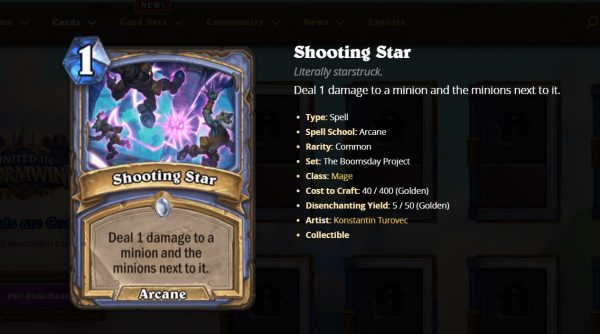
Next up is Spell Mage, a deck that came out almost overnight when Ashes of Outland was released. This is because Ashes of Outland gave the deck a lot of cool cards that help in its play style. Specifically, Font of Power and Incanter’s Flow. When your deck is almost always all spells, these cards have pretty devastating and game-turning effects.
The deck is a bit weird. It plays like a Control deck, but there’s also shades of midrange, and even Aggro if you squint hard enough. Though that’s probably because they can swarm the opponent if they get good enough stuff on their spells. Either way though, their main closing technique is to ensure that the opponent gets shanked by burn damage. Though they can also make use of summoned minions to close out the fight.
Unfortunately, though, this isn’t viable in the current Meta. It also doesn’t help that Forged in the Barrens and Wailing Caverns didn’t have good cards to improve the deck on. Thus, Spell Mage is stuck at B Class because the deck gets crushed by decks like Aggro Hunter and Rush Warrior. Still, Spell Mage is the only Mage deck currently on the Ladder, which makes it a rare sight, but one to keep an eye out for due to its abilities.
Spell Mage Deck List
- Brain Freeze x2
- Devolving Missiles x2
- Font of Power x2
- Primordial Studies x2
- Shooting Star
- Cram Session x2
- Incanter’s Flow x2
- Runed Orb x2
- Arcane Intellect x2
- Combustion x2
- Deck of Lunacy
- Fireball x2
- Ring Toss
- Apexis Blast x2
- Refreshing Spring Water x2
- Flamestrike
- Mask of C’Thun x2
Clown Druid
Last but not least for the A-Class is Clown Druid, a Ramp Druid variant that came out on Darkness of the Darkmoon Faire. Like its original counterpart, the archetype uses a lot of cards that ramp them up quickly like Overgrowth. In addition, they also make use of cards that give mana for one turn like Lightning Bloom. This is so that they can summon high mana cost minions or spells before their opponent does.
As for why the deck was created, it’s because of a card called Carnival Clown, which is the deck’s sole win condition. This, when combined with cards like Y’Shaarj the Defiler and Strongman, as well as Corrupt Keyword, can obliterate enemies. When the deck finally has the mana to bully the enemy into submission, and the cards align, this deck can be destroyed.
Unfortunately, the deck didn’t get any support on the Forged in the Barrens expansion nor on the Wailing Caverns mini-set. It’s unfortunate; the deck struggled to get out of B Tier for a few months now, and the current meta’s not doing the deck any favors. Luckily, any savvy Clown Druid player can still kick ass if they’re good enough. However, it’s still not enough to put Clown Druid on the A-Class decks.
Clown Druid Deck List
- Innervate x2
- Lightning Bloom x2
- Animated Broomstick x2
- Nature Studies x2
- Guess the Weight
- Wild Growth x2
- Blademaster Samuro
- Overgrowth x2
- Thickhide Kodo
- Lake Thresher x2
- Twilight Runner x2
- Strongman x2
- Guardian Animals x2
- Primordial Protector x2
- Carnival Clown x2
- Survival of the Fittest x2
- Y’Shaarj, the Defiler
C Class
Lastly, we have the decks in the C Class, AKA the bottom of our hearthstone Arena tier list. These decks are usually pretty good, but a lack of support led to their eventual fall from grace. In their current state, it’s not recommended for players to bring these decks in ranked. We’ll start our count with Control Warlock, and finally, Control Warrior.
Control Warlock
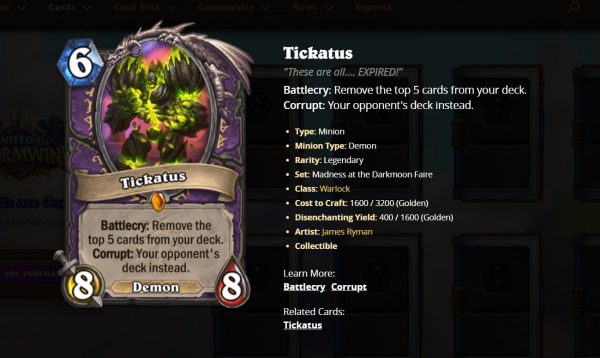
Control Warlock is a deck that epitomizes the original playstyle that Control decks used to have. Namely, being a brick wall and incredibly defensive, make sure that the enemy runs out of cards to play, then fight back. The win conditions and game plans that Control Warrior has will vary depending on what deck they’re playing against.
For example, slower decks like Spell Mage means that Warlocks need to use beat sticks when they feel they run out of spells to use. Normally, that would be Bloodreaver Gul’dan, but he’s been rotated out. Thus, Tickatus or an Old God reprint is a viable solution. Forged in the Barrens gave the deck a better chance though, as the new expansion buffed Lord Jaraxxus and Siphon Soul. In addition to this, the expansion was added in Tamsin Roame.
Wailing Caverns on the other hand, really screwed Control Warlock over, as the mini-set and meta didn’t do it any favors. When fighting against Control decks, Control Warlock can kick their asses six ways to Sunday. However, other than Control Priest, the Control decks from other classes are just not viable in the current meta. Most of them, including Control Warlock, need to have a major overhaul before any of them can climb the meta ladder again. That overhaul, however, doesn’t seem to be coming any time soon. Thus, Control Warlock is on C Class, alongside another Control Deck.
Control Warlock Deck List
- Armor Vendor x2
- Spirit Jailer x2
- Drain Soul x2
- Soul Shear x2
- Luckysoul Hoarder x2
- School Spirits x2
- Tamsin Roame
- Venomous Scorpid x2
- Cascading Disaster x2
- Hysteria x2
- Ogremancer x2
- Taelan Fordring
- Tickatus
- Soulciologist Malicia
- Strongman
- Twisting Nether
- Alexstrasza the Life-Binder
- Lord Jaraxxus
- Y’Shaarj, the Defiler
Control Warrior
Last on the list is Control Warrior, a deck that wants to get as much armor as possible to tank hits. After that, they’ll then destroy the opponent’s board with board-clearing effects. This deck was a staple of Hearthstone ever since the game came out and the overall strategy has been pretty consistent even after several new cards and bans. The game might’ve changed considerably, but the playstyle hasn’t.
Unfortunately, though, Control Warrior feels lackluster in the current meta. In fact, at its current iteration, most control decks have been shanked by the game and don’t feel as viable anymore. They needed a lot of assistance from cards not usually added into the deck to be viable. Combine the fact that their endgame strategies just aren’t cutting it. Getting C’Thun, the Shattered, or Alexstrasza, the Lifebinder is cool, yes. But they’re just not consistent, nor are they viable in most situations.
Control decks need find a better way to ply their trade, as well as an actual, viable, endgame to focus on. The only reason why Control Warrior is even here in the meta? That’s due to the addition of Outrider’s Axe and Rancor from the Forged in the Barrens expansion. In addition, Shieldmaiden, an old staple, is making a comeback, another reason for Control Warrior’s presence in the meta.
Control Warrior Deck List
- Shield Slam x2
- Stage Dive
- Sword and Board x2
- Corsair Cache x2
- Minefield x2
- Coerce
- Lord Barob
- Mor’shan Watch Post x2
- Kargath Bladefist
- Outrider’s Axe x2
- Rancor x2
- Sword Eater x2
- Brawl x2
- Cutting Class x2
- Shieldmaiden x2
- Taelan Fordring
- Alexstrasza the Life-Binder
- Rattlegore
- C’thun, the Shattered
Should You Immediately Use S-Tier Deck Classes?
It depends. If you have the cards to create the decks in this Hearthstone Arena tier list, then yes. Hearthstone’s PvP community is incredibly competitive even to this day. If you’re playing casually, then it’s usually fine to just experiment and fumble around on your own for decks that fit your playstyle.
However, if you’re playing for keeps on the game’s ranked ladder, this Hearthstone Arena tier list becomes necessary. The game’s competition is so tough that using anything other than the Meta decks can turn your ranked ladder climb into a nightmarish slog. Don’t let that stop you though. After all, experimentation is the name of the game. There’s even the chance that you might find a pretty OP deck build by yourself if you experiment enough.
In short, if you’re playing outside the Ranked ladder, be as whacky as you want. When climbing ranked though? Get a Meta deck, unless you’re confident in the deck you’re currently running.
Are The Deck Classes At The Bottom Unplayable?
As stated above, it depends on where you’re playing them, as well as your preferred playstyle. Playing the decks at the bottom of our Hearthstone Arena tier list doesn’t mean that you can’t win. It just means that you have fewer chances to win compared to your enemy. These decks can and do kick ass when the stars align. And like what we said above, play however you like, but if you want to climb the ranks faster, go Meta. This Hearthstone Arena tier list is just like a usual tips and tricks guide. You can still enjoy the game however you seem fit.
How Does Hearthstone Fare Against Similar Games?
Now that we’ve talked about Hearthstone and our Arena tier list, let’s talk about other games like it. We’ll start with Shadowverse, then Legends of Runeterra, Yu-Gi-Oh: Duel Links, and finally, Magic the Gathering: Arena.
Shadowverse
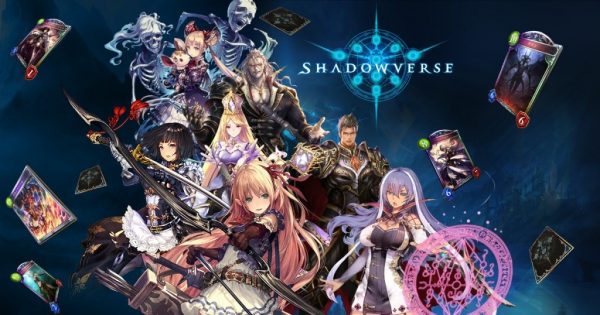
Shadowverse is yet another collectible card game created and released by Cygames back in June 2016. The game’s been compared to Hearthstone for quite a while now, and to be fair, their gameplay is similar. There are a few differences that make Shadowverse different though.
For one, the art style that Shadowverse has is more rooted in an Anime aesthetic, from characters to cards. This is mostly due to Cygames being based in Japan, but that’s just a fringe reason why that’s the case. In addition to that, a few of the cards in the game, or more accurately their illustrations, came from a previous title, Rage of Bahamut. They pulled the plug on that game back in 2016. However, some consider Shadowverse to be its spiritual successor due to the illustrations in the game and its release date.
Other than that though, the game’s developers wished to reduce how impactful randomness can be in the outcomes of games. There’s also the Evolution Mechanic, which gives extra stats and maybe effects on units at the cost of Evolution points. Evolution points are something added into the game to add a bit of spice to it. There’s still a Mana point that increases every turn that’s used to summon and cast spells, yes. However, the Evolution Point mechanic was added in a new addition to the game.
Combine that with frequent updates and careful game balancing? You can see why Shadowverse is thought of favorably by Digital TCG/CCG fans. Shadowverse has been one of the more prominent Hearthstone competitors in the current generation.
Legends of Runeterra
Next up is Legends of Runeterra, Riot Games’ foray into the Online TCG/CCG gaming market. As you can probably guess, Legends of Runeterra is based on Riot’s Dota clone League of Legends created in 2020. The main goal of the developers when creating Legends of Runeterra was to reduce its barrier of entry. This meant that players without any experience with Hearthstone or Shadowverse can play the game better, faster. In addition to this, Legends of Runeterra changed up how the usual Digital CCG game is played.
For one, the game’s rounds make it so that all players take action immediately after the other. For example, when one player summons a unit, the opposing player summons another unit or casts a spell. After the preparations, players then attack, with the player being attacked getting the ability to block an attacking unit. Players take turns each round on who gets to attack. However, some cards have the ability to Rally. AKA, the player with the card/unit that has the ability can attack even when it’s not their turn. After attacking, and other additional spells/minions are put on the field, the round ends. In addition to this, any unused action points will be placed on a spell gauge that maxes out with 3 Mana points.
All in all, the game is, though not easier, at least easier to get into compared to Hearthstone. The game has its nuances, of course, and there are many different kinds of decks. However, the game doesn’t force-feed the player these mechanics at the start of the game.
Yu-Gi-Oh: Duel Links
Next up we have Yu-Gi-Oh: Duel Links, which is considered to be one of the OG Trading Card games in the world, mostly because of the popularity of the anime. However, Duel Links takes a lot of inspiration from the real TCG, with almost all of the cards being exact copies of the real thing. Even the gameplay’s the same, as the game follows the OG rules.
There’s honestly no need for introduction in Duel Links. If you know how to play Yu-Gi-Oh, you can immediately start playing matches. Of course, you need to build your deck, and unfortunately, you can’t just pick the cards you want willy-nilly. This is because the game is monetized heavily, with players needing to purchase card packs to get new cards. Luckily, players can farm gems by leveling up characters and doing in-game actions and missions. Though honestly, that’s not enough. Still, the game is a great way to play Yu-Gi-Oh if you don’t know anyone IRL to play with. That, or if you don’t have a deck of your own.
Magic the Gathering: Arena
Last but not the least, Magic the Gathering: Arena, an online version of the hit Tabletop Collectible Card Game created by Wizards of the Coast. Same as Yu-Gi-Oh: Duel Links, if you know how to play MtG, you can immediately play MtG: Arena.
However, the same ills plague it. You need to buy booster packs to get new cards, and booster packs need premium currency. If you’re willing to spend a few dollars on it, you can get some pretty good cards. Still, this is pretty much par for the course with Digital CCGs anyway. If you’re the kind of guy who used to love playing MtG, then Magic the Gathering: Arena is a great way to play it.
